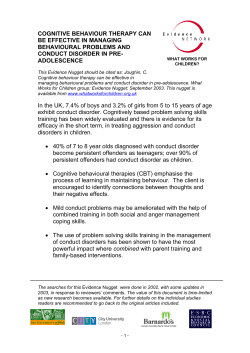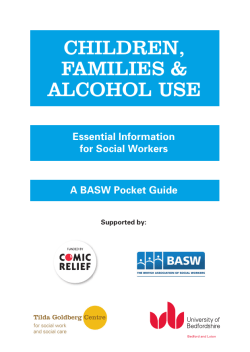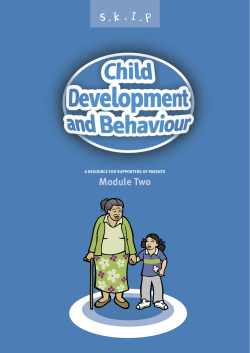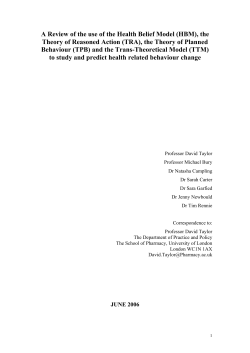
Promoting Children’s Emotional Health Research Review
Research Review Promoting Children’s Emotional Health Rachel Smith, Policy, Research and Influencing Unit September 2002 Picture by Samantha Seaton Children’s Emotional Health Why is emotional health important? “Health is the basis for a good quality of life and mental health is of overriding importance in this” (Article 24 of the United Nations’ Convention on the Rights of the Child) Bart Essentials Bart Essentials There are approximately 14.9 million children and young people under 20 living in the UK, representing 25% of the population. A substantial minority of children – up to 45% - are likely to experience moderate or severe psychological problems at some point in childhood or early adulthood. It is suggested that at any one time, up to 20% of children and young people may be affected by emotional and behavioural problems, most commonly anxiety disorders, disruptive disorders and attention deficit hyperactivity disorder (Buchanan, A., 1999, p.1). While a large proportion of children will recover without any need for specialist help, a worrying continuity has been observed between childhood problems and adult outcomes, particularly where no effective interventions have been offered. Without intervention, the possible consequences of emotional and behavioural difficulties are as follows: 1. Consequences in childhood Poorer family relationships Lower levels of school achievement Greater risk of school suspension/expulsion Links with offending behaviour Fewer qualifications Poorer employment prospects Social exclusion 2. Consequences in adulthood Poorer relationships with partners and own children Links with mental health problems in adult life Possible links with a range of serious physical illnesses (Buchanan, A., 1999, p.17) Risk and protection factors Longitudinal studies in the UK, USA and elsewhere in the Western world show that a range of factors in children’s early lives have been consistently associated with increased risk of mental health problems in adolescence and adulthood (MHF, 1999, p7). The greater the number of risks, and the more severe the risks, the greater the likelihood of the child developing a mental health problem. If a child has only one risk factor in their life, their risk of developing a mental health problem has been defined as being 1-2%. However, with three risk factors the likelihood increases to 8%; and with four or more risk factors the likelihood of the child developing a mental health problem is increased to 20% (MHF, 1999, p7). Evidence suggests that children’s emotional well-being can improved if the number of risk factors is reduced, and the number of protective factors is increased. PAGE 2 of 15 Bart Essentials A central finding in the literature on psychosocial adversities is that some individuals are more resilient than others. There are children who, against all odds survive intact and develop into competent, confident and caring adults despite prolonged and negative experiences. An important key to promoting children’s mental health is, therefore, a greater understanding of these protective factors that enable some children to be resilient (MHF, 1999, p.9). There is a broad consensus that factors that can promote childhood resilience are located in the following domains: The physical and emotional attributes of the child The child’s family The immediate environment in which the child lives Intervening effectively yields huge benefits in reducing a number of problems that are of concern to government, school, parents and children (Mental Health Foundation, 1999, p.7). Table 1: Key risk and Protection factors for emotional and behavioural problems (Buchanan, A. & Ten Brinke, J.A, 1998; The Mental Health Foundation, 1999) Risk factors Protective factors Factors in the Person Genetic factors making the children more vulnerable to emotional and behavioural problems Temperament Impulsiveness Physical illness/impairment Mental disabilities Communication difficulty Low self-esteem Biological resilience Good health and development Good problem solving skills/ IQ Being female Secure attachment Good communication skills Humour / religious faith Belief in control Factors in the Family Family adversities Poverty Mental illness in the parents Alcoholism, criminality Conflict with and between parents Good relationship with parents Affection Supportive grandparents Lack of domestic tensions Family involvement in activities PAGE 3 of 15 Bart Essentials Lax, inconsistent discipline Punitive, authoritarian/inflexible parenting Death and loss Physical, sexual &/or emotional abuse Being brought up by birth family Factors in the school/ community Poor reading/low school attainment Bullying in schools Disadvantaged community/ neighbourhood crime Racial tension/harassment An experience of public ‘care’ Supportive community Schools with good rates of achievement, good ‘ethos’, lack of bullying Opportunities for involvement and achievement Good housing High standard of living Range of positive sport/leisure activities Factors in the wider world Economic recession Unemployment Housing shortage Family change: increasing Family breakdown Long working hours/ job insecurity ‘Inclusive’ policies Which children comprise the key target population? Specific groups of young people are at higher risk from developing emotional and behavioural disorders: Children whose parents are divorcing A minority of children experience long-term psychological problems following divorce. The worst outcomes are likely to occur when the break-up is surrounded by conflict. PAGE 4 of 15 Bart Essentials Children living with parental mental illness It is thought that between five and seven million adults are suffering from mental illness at any one time, and 30% of these will have dependent children (0-18 years old). Although some parents with mental health problems can adequately care for their children, all such children are at risk of emotional and behavioural problems and some are at risk of significant harm. Children who run away from home It is estimated that 43,000 young people ran away in England and Scotland in 1990. Most are aged between 14-17, but 7% are aged 11 or less. These young people are at risk as victims of crime and at risk of committing crime. Children living with domestic violence Exposure to discord and hostility between parents is an important determinant of emotional and behavioural problems in children; especially if the discord is persistent over time and the child becomes embroiled in hostility between the parents. Children in care More than one in four children who have been in care have significant levels of maladjustment (Buchanan & Ten Brinke, 1997). Research in Oxfordshire in 1998 found 67 per cent of those in the care system and 96 per cent of those in children’s homes and secure units have ‘clinical’ levels of psychiatric illness (McCann, James, Wilson & Dunn, 1996). Young offenders Young prisoners are one of the most excluded and most needy groups in society. There are currently more than 11,500 young people aged 15-20 in jail. Of these, 90 per cent have a diagnosable mental illness, substance abuse problem, or both (Lyon, Dennison & Wilson, 2000). They are 13 times more likely than other children to be looked after by their local authority, and 20 times more likely to have been excluded from school. Rather than resolving the difficulties of these young people, prison often compounds their problems (Lyon, J., 2002). Within two years of their release, three-quarters will have re-convicted and 47 per cent will be back in jail (Social Exclusion Unit, 2002). What interventions work? This section describes factors and interventions associated with the promotion of resilience in the period of first school entry, to early adolescence and entry to secondary education. PAGE 5 of 15 Bart Essentials Children’s emotional well-being can be improved by reducing the number of risk factors, particularly family difficulties, and increasing the number of protective factors. All protective strategies operate through one or more of the following processes: By altering the child’s perceptions of, or exposure to risk By reducing the chain reaction that takes place when risk factors compound each other and multiply By helping the child improve self-esteem and self-efficacy By creating opportunities for change General factors promoting resilience in the middle years Valuing and tolerating different cultural characteristics during the school entry period. Positive school experiences: academic, sports or friendship related. Good and mutually trusting relationships with teachers. Provision of breakfast and after-school clubs. Good home–school liaison arrangements, and where necessary on-going homeschool links, where parents lack confidence in their parenting ability or are disengaged from the educational process. In situations of marital discord, attachment to one parent, moderation of parental disharmony and opportunities to play a positive role in the family. In abusive settings, the opportunity to maintain or develop attachments to the non-abusive parent, other family member, or failing these, a reliable unrelated adult; maintenance of family routines and rituals. Manageable contributions to the household which promote competencies, selfesteem and problem-solving coping. Stable accommodation. Community based initiatives that help to build social capital. The development of skills, opportunities for independence, and mastery of tasks. Structured routines and a perception by the child that praise and sanctions are being administered fairly. Help to resolve minor but chronic stressors as well as acute adversities. Encouragement to develop or adopt positive cognitive styles of thinking. Active support from external sources, including mentors, where children are at risk of developing patterns of anti-social or criminal behaviour. (Newman, T., 2002) PAGE 6 of 15 Bart Essentials Evidence suggests that it is easier to change a younger child’s behaviour than the behaviour of an older child, however, at present there are far fewer well-validated programmes for older children. Examples of general Prevention projects Teaching primary-aged children social awareness and problem solving in school There are a number of possible reasons why this type of intervention is effective. Firstly, these are ‘whole’ class programmes, so no child is stigmatised. The children are taught not only to recognise emotions, but are also taught the skills to problem solve. Finally, the main focus is on younger children who respond quicker than older children. Elias and Clabby (1989) evaluated a Social Problem Solving Project in primary schools. The project involved: Teaching skills linked with self-control, turn-taking, impulse control, regulating emotions, and communication Problem-solving and decision making skills Behaviours linked to peer acceptance Applying skills in changing social situations An evaluation of the project revealed significant gains in interpersonal sensitivity, problem analysis and specificity of planning (Buchanan, A., 1999, p.79). School wide anti-bullying programmes Bullying is a major concern for young people in school. Research by Olweus (1993) showed that reduction in bullying is associated with less antisocial behaviour. A whole school policy was adopted at a school in Norway, with the goal of reducing bullying, establishing an awareness of the problem, and improving the social milieu of the school. The intervention sought to establish firm limits of acceptable and unacceptable behaviour; provide consistent application of non-hostile and nonphysical sanctions for rule restrictions; and involve parents and teachers. Classes of 11-12 year olds involved in the intervention showed a greater reduction in bullying than controls. Parallel reductions were also noted in antisocial behaviour such as vandalism, theft and truanting. A school anti-bullying ‘ethos’ may directly influence levels of antisocial behaviour operating in the community (Buchanan, A., 1999, p.80) Peer-led life skills teaching with adolescents PAGE 7 of 15 Bart Essentials The secret of effective intervention is getting both the timing and the approach right. In early adolescence the key motivator is the peer relationship, and programmes tapping into this relationship have proven successful. Peer-led programmes focus on the positive and do not preach. GOAL is an information and skills based programme on health-enhancing and health- compromising behaviours, for adolescents’ aged 10-15. After school focus groups were run by student leaders for up to 15 younger pupils. The sessions included subjects such as: Dare to dream; setting goals; making a goal ladder; identifying and building your strengths; going for goals. The participants largely achieved their goals, and compared to a control group had less reported increase in health compromising behaviours, less violence and problem behaviours, and better school attendance (Danish, S.J. et al, 1989, cited in Buchanan, A., 1999, p.81). The Northumberland Young People’s Project, led by young people, aims to develop effective and user-friendly models of health care, improve young people’s access to the existing range of services, and encourage their involvement as central to the developmental process. Sessions were held outside the conventional ‘health’ setting on a drop-in basis, between July 1996 and July 1998. Young people carried out an evaluation of the service. Family planning was found to be the main subject of inquiry. The number of conceptions in young women under 16 fell from a high of 34 for the first six months of 1996 to a low of 10 for the first six months of 1998. A major achievement of the project is that males were able to access the service (gender ratio 51% male, 49% female). The key ingredients of this project were thought to be confidentiality, the supported involvement of interested local young people, publicity material by young people, and the rights and responsibilities of everyone at the session clearly displayed (Buchanan, A., 1999, p.81). Structured parenting group programmes teaching child development and behavioural management of problem behaviour Research into risk and resilience has clearly shown the fundamental role that families have in promoting children’s mental health (MHF, 1999). In the UK, parenting programmes are often run in family centres as part of a wider programme of activities. Parenting programmes can be for parents who want to do a ‘good enough’ job of parenting; for those whose children have behavioural problems; and for parents with multiple problems and very low self-esteem. So far research on the effectiveness of the family centres is limited, but it is felt that the centres have a real indirect benefit. Family centres are often in areas of social disadvantage, and given the high levels of depression and feelings of isolation in mothers, the centres play an important role in limiting the numbers of children with emotional and behavioural problems (Buchanan, A., 1999, p.75&76). PAGE 8 of 15 Bart Essentials Based in Durham, Positive Parenting is a programme run in schools, community centres and family centres. The objectives of the course are to empower parents to recognise their existing skills, and prioritise and work systematically towards clear, planned targets. An evaluation of the project revealed that parents recognised they were already experienced in the skills of parenting; they learnt new approaches to child management; they felt like valued partners in their child’s development and felt valued as adults who were worthy of investment and training (MHF, 1999, p25). Effective Parenting is a primary-school based programme designed to support parents. It provides a forum to share experiences, fears and anxieties; to pool practical tips; to develop better understanding of relationships and behaviour, and to understand the different stages of a child’s development. The aim of the programme is to bridge the divide between school and home, and to raise both parents’ and children’s self-esteem. An evaluation of the programme found that the courses were effective in transferring general competence and group work skills (Mental Health Foundation, 1999, p.26) Durlak (1997) carried out an analysis of 200 studies of primary prevention mental health programmes for children and adolescents. Although anecdotal evidence, parents’ self-reporting and the views of a range of professionals all suggest positive outcomes for both parents and children, he found that programmes relying exclusively on parent training did not produce significant overall positive effects (Buchanan, A., 1999, p.74) Examples of specific prevention programmes There are a large number of areas of children’s emotional health that we could address, but we have chosen to focus on three examples of issues likely to affect children in the 5-14 age range. These are parental separation, bereavement, depression and children at risk of exclusion from school. Depression The development of positive thinking in children is an important factor in protecting children against depressive disorders. There is considerable evidence that children’s latent resilience can be stimulated by interventions aimed at promoting learned optimism through the medium of cognitive restructuring. The changing of children’s patterns of thinking from negative to positive through the medium of cognitive behavioural therapy has been implemented with some success in the school-based Penn Prevention Programme, delivered to a general, not a clinical population. Strategies involved the use of comic strip characters (“Hopeful Howard”, “Gloomy Greg”, “Pessimistic Penny”, “Say it straight PAGE 9 of 15 Bart Essentials Samantha”), role playing, games, discussions and videos, in a 12 week programme. A 50% drop in levels of depression was noted in the intervention group and there was no change in controls, where both groups had similar baseline profiles (Seligman, 1998). Although trials have examined the efficacy of several forms of psychotherapy for depression in adolescents, only trials of cognitive behavioural therapy (CBT) have included prepubertal children. CBT is a promising treatment, but its application is limited by the number of available practitioners, as few have the necessary training. CBT may prove most useful as a preventive measure against depression (Hazell, 2002). Divorce The well-being of the child is strongly associated with the well-being of their parents, and the quality of their mutual relationship. Psychotherapeutic interventions with children themselves aimed at preventing or moderating the effects of divorce on emotional health seem of limited effectiveness, though there is more evidence of a positive effect on parents. Where separation occurs, the most powerful resilience-promoting factor is the extent to which the parents minimise conflict. Few differences between children in divorced or non-divorced families are detectable where there is an absence of conflict with the non-resident parent and where a single parent is able to provide a positive and nurturing home environment (Hetherington and Stanley-Hagan, 1999). The Children of Divorce Intervention Programme (CODIP) is a well-validated school-based preventive mental health programme (Pedro-Caroll & Cowen, 1985). Programmes were run for young children through to adolescents, with the aim of creating a supportive group environment where children can share their experiences, clarify misconceptions and develop skills to cope with changes. Programmes were geared to the needs of each age group, and were evaluated extensively on different populations and ages. When compared to matched controls, the children show significant improvement in behaviour and competence. Their parents reported better home adjustment, communication reduction in divorce related concerns. On follow up, it was found that the improvements had been maintained and the children were more positive about the future. Bereavement In cases of bereavement, a conscious attempt to build resilience is likely to be more effective when designed as an educational process aimed at improving PAGE 10 of 15 Bart Essentials confidence rather than as a primarily therapeutic tool (Barnard et al. 1999). Support groups where children are able to share their experiences with others can lead to new and more effective ways of coping (Black, 1998). Tonkins et al (1996) looked at the effectiveness of eight-week children’s bereavement psychotherapy. The group was directed at those children suffering the loss of a parent or a sibling. Bereaved siblings in the experimental group showed a significant decrease in grief following group treatment compared to a waiting list control group. However, a judgement about the effects of interventions supporting bereaved siblings cannot be made at present, as there have been few empirical studies. Mulcahey & Young (1995) evaluated three activity-based support groups (preschool, school age and adolescent). They found that all groups served to reduce anxiety around the issue of death, and decrease isolation caused by loss. Offering bereavement support groups for children and parents promoted family communication and healing. However, a review of community-based support services for bereaved children (Curtis and Newman, 2001) concluded that while clear benefits could result for children in some circumstances, the case for the universal inclusion of all bereaved children in such support programmes remains unproven. Children at risk of exclusion from school There is encouraging evidence that mentoring services are effective at improving behaviour of children at risk of exclusion from school. Roberts and Singh (1999) carried out an evaluation of CHANCE, a community-based project in London offering early intervention for children at risk of long-term behaviour problems, school exclusion or criminality. The project successfully recruited and retained mentors, and created good and trusting relationships between mentors and the children. According to mothers, the teachers and mentors have had some success in improving the children’s behaviour. Standardised measures of behaviour indicated that children had transferred gains from home to the school environment, but similar gains were noted in a non-intervention comparison group, indicating these gains might be due to maturation, not necessarily the intervention. A project run by the Home Office Programme Development Unit in Yorkshire uses social work trained staff in schools, supporting children and young people (aged 10-14) who are at risk of exclusion. Vulliamy and Webb (1999) found that the home-school support workers were helping to bring about a reduction in permanent exclusions, and a considerable reduction in fixed-term exclusions. There were also reductions in truancy due to increased home-school communication and direct intervention. PAGE 11 of 15 Bart Essentials A number of clear themes emerge from an analysis of US and UK based intervention projects: 1. The presentation of a project is crucial. Projects need to be non-stigmatised and meet the needs of the individual at that particular life-cycle stage. 2. It is easier to alter a primary school child’s behaviour than an adolescent’s. 3. At different times, children, young people and parents are more ‘open’ or ‘closed’ to interventions. Interventions at times of transition are usually more effective. 4. Some of the most needy parents cannot, or will not go to projects. They need to be seen at home. 5. Information alone is not enough, people also need to be taught relevant strategies and skills. It is also important for children to learn planning, learning and problem solving skills, and to learn strategies for managing social relationships (Buchanan, A., 1999, p.84) What looks promising? 1. Father involvement In 1996 and 1998 two studies sought to find out how boys with low self-esteem differed from girls with low self-esteem, and what the association was between high and low self esteem; depression; and disaffection from school. The studies elicited the views of 4,000 young people aged 13-19 who responded to a newspaper questionnaire. In both studies the sample was divided between a group of young people who were at either end of the spectrum. The most significant difference between the high and low self-esteem groups for both boys and girls related to their families’ parenting style. However, another group of characteristics clearly divided high and low self-esteem boys. This was the relationship between fathers and sons. Boys whose fathers were ‘involved’ had higher self-esteem, were less likely to be alienated from school, less likely to be involved in criminal activities and less likely to be depressed. An involved father was one who spent time with his son, took an interest in his schoolwork and talked to him about his worries and relationships (Buchanan, A., 1999, pp.33&39). PAGE 12 of 15 Bart Essentials Evidence that ‘father-involvement’ is protective against a range of life’s adversities suggests more could be done to involve fathers. A number of projects in the UK have begun to address this issue. In London, Working with Men initiates programmes and training for professionals intending to take up this type of work. In Norwich the Mancroft project has a Fathers’ group that meets one evening a week covering issues such as legal rights, and practical child care knowledge. Neither of these has been evaluated to date. Father’s Plus, working for and with dads in Tyne and Wear, has undertaken an audit of projects in the North East working with fathers (Buchanan, A., 1999, p.69). 2. Telephone help-lines The work of CHILDLINE and the SAMARITANS is well known, but there are now a number of telephone help-lines available to both young people and parents. These include PARENTLINE, a free phone help-line run by the National Step Family Association, and RELATEEN, a regionally based telephone help-line to help young people deal with their relationships (Buchanan, A., 1999, pp.82&83). The CHILDREN’S LEGAL PROTECTION CENTRE also have a confidential advice line and provide free legal advice on all aspects of law and policy affecting children and young people. The help-line is available to both adults and young people. YOUNG MINDS runs a free, National Information Service for parents, carers or professionals who are worried about the mental health or emotional well-being of a child or young person. Trained ‘frontline’ staff deal with initial contacts, but people needing detailed advice are offered a call back by one of Young Minds 10 professional advisers. An independent evaluation of the service carried out in 1997 found that nearly half the calls related to young people between 12 and 17, peaking at 15 years. Ninety-five per cent of the 1533 contacts were made telephone, and more than half the callers reported that the call had made either ‘a lot’ or ‘quite a lot’ of difference to the way they saw their problems. Only 13% said it had made no difference at all. More than 90% said that there had been definite advantages in having been able to contact the service by telephone. It was felt to be quicker and more accessible and many said they had found it easier to talk about the problem over the phone than face to face (Buchanan, A., 1999, p.82&83). 3. Mentoring Mentoring has been targeted at groups of children experiencing difficulty in their lives as a result of their challenging behaviour. Mentors aim to offer these individuals support, understanding, experience and guidance. Programmes have PAGE 13 of 15 Bart Essentials proved that they can attract and retain volunteers, and when mentoring relationships succeed both mentors and mentees find it a positive experience. The reported number of successful mentoring relationships, that is those maintained over the evaluation period, is high (St James-Roberts et al (2001); Tierney et al (2000); Tarling et al (2001)). The Big Brother Big Sister (BBBS) project (Tierney et al (2000)) is a large US study frequently cited as an example of the success of mentoring. BBBS reports claim that the young people who took part in the programme were less likely to start using drugs or alcohol, less likely to hit someone, had improved their school attendance and performance, and had improved their relationships with their family following the period of mentoring. However, these claims are based on selfreports given by the young people, and no attempt was made by the BBBS team to verify the young people’s reports. While mentoring is widely recommended and receives positive feedback from children and parents, it lacks empirical evidence to show that it really is successful at achieving the outcomes it claims. Studies have not yet looked for changes in the long term, so we cannot know whether mentoring has an impact in the future of these young people. However, it is felt that mentoring is an issue worth pursuing, though more attempts need to be made to find stronger evidence to back up the claims of positive change. Conclusion During childhood and adolescence young people have to learn the skills to cope as a successful adult. Although there are gaps in the research on what works with children with emotional and behavioural problems, there are some clear messages. Key elements for an effective intervention are a clear and specific assessment, building up a trusting relationship with the child, the support of the parents or carers, and a sense of the strengths and risks in the wider community. Information alone will not motivate behaviour change. Systematic skill training is needed to develop prevention-related behaviours, and mechanisms must be put in place to support and reinforce behaviour change after it occurs. References Barnard, P., Morland, I., & Nagy, J. (1999) Children, Bereavement and Trauma: nurturing resilience, London: Jessica Kingsley Black, D. (1998) Bereavement in childhood, British Medical Journal, 316:93331-3 Buchanan, A. (1999) What Works For Troubled Children? Family support for children with emotional and behavioural problems, Barnardo’s PAGE 14 of 15 Bart Essentials Buchanan, A. & Ten Brinke, J-A (1998) Recovery from Emotional and Behavioural Problems. NHS Executive, Anglia and Oxford. University of Oxford. Buchanan, A & Ten Brinke, J-A. (1997) What Happened When They Were Grown Up: Outcomes from parenting experiences. York: Joseph Rowntree Foundation Curtis, K. & Newman, T. (2001) Do community-based support services benefit bereaved children? A review of empirical evidence. Child: Health Care and Development, 27, 6:487-95 Danish, S.J., Mash, J.M., Howard, C.W. et al. (1992). Going for GOAL. Leader Manual and Student Manual Department of Psychology, Virginia Commonwealth University, US. Durlak, J.A. (Ed.) (1997). Prevention of behavioural and social problems (chapter 2) in J.A. Durlak Successful Prevention Programs for Children and Adolescents. New York, Plenum. Elias, M.L. & Clabby, J.F. (1989) Social Decision-Making Skills: A curriculum guide for the elementary grade, Rockville, MD, Aspen Publishers Hazell, P. (2002) Depression in Children. British Medical Journal, 325:229-230 Hetherington, E.M. & Stanley-Hagan, M. (1999) The adjustment of children with divorced parents: a risk and resiliency perspective, Journal of Child Psychology and Psychiatry, 40, 1:129-140 Katz, A., Buchanan, A., & McCoy, A. (1999) Leading Lads. Obtainable from Young Minds, 12 Bride Gardens, East Molesley, Surrey KT8 9HU Katz, A., Buchanan, A., & Ten Brinke, J-A. (1997). The Can Do Girls. Report funded by The Body Shop, obtainable from Department Applied Social Studies and Research, University of Oxford Lyon, J. (2002) Prevention Not Detention. Community Care 8-14 Aug Lyon, J., Dennison, C., & Wilson, A. (2000) Tell Them So They Listen. Messages From Young People In Custody. Home Office Research Study 201. The Mental Health Foundation (1999) Bright Futures: Promoting children and young people’s mental health, MHF PAGE 15 of 15 Bart Essentials McCann, J., James, A., Wilson, S., & Dunn, G. (1996) Prevalence of psychiatric disorders in young people in the care system. British Medical Journal 313, 1529-30. Mulcahey, A.L. & Young , M.A., (1995) A bereavement support group for children: fostering communication about grief and healing. Cancer Pract. May-June, 3(3) 150-6 Newman, T. (2002) Promoting Resilience: A Review of Effective Strategies for ChildCare Services. Prepared for the Centre of Evidence-Based Social Services, University of Exeter. Olweus, D. (1993). Bullying in School: What we know and what we can do. Oxford. Blackwell. Pedro-Caroll, J.L. & Cowen, E.L. (1985) The Children of Divorce Intervention Programme. An investigation of the efficacy of a school-based prevention programme. Journal of Consulting and Clinical Psychology, 14, 277-90 Seligman, M. (1998) Learned Optimism, New York: Pocket Books Social Exclusion Unit (2002) Reducing Re-offending by Ex-offenders St James-Roberts, I. & Singh, C.S. (2001) Can mentors help primary school children with behavioural problems. Final report of the three year evaluation of Project CHANCE carried out by the Thomas Chorma Research Unit between March 1997 and 2000, Home Office Research Study No. 233, Home Office Research, Development and Statistics Directorate. Tarling, R., Burrows, J. & Clarke, A. (2001) Dalston youth project part II (11-14) an evaluation. 232. Home Office Research, Development and Statistics Directorate. Home Office Research Study. Tierney, J.P., Grossman, J.B. & Resch, N.L. (2000) Making a difference. An impact study of Big Brothers Big Sisters. Philadelphia, PA USA, Public/Private Ventures Tonkins , S.A.M. & Lambert, M.J. (1996) A treatment outcome study of bereavement groups for children. Child and Adolescent Social Work, 13(1), 3-19 Vulliamy, G. & Webb, R. (1999) Meeting need and challenging crime in partnership with schools, Home Office Research Development and Statistics Directorate, Research Findings No. 96 PAGE 16 of 15 Bart Essentials PAGE 17 of 15
© Copyright 2025


















